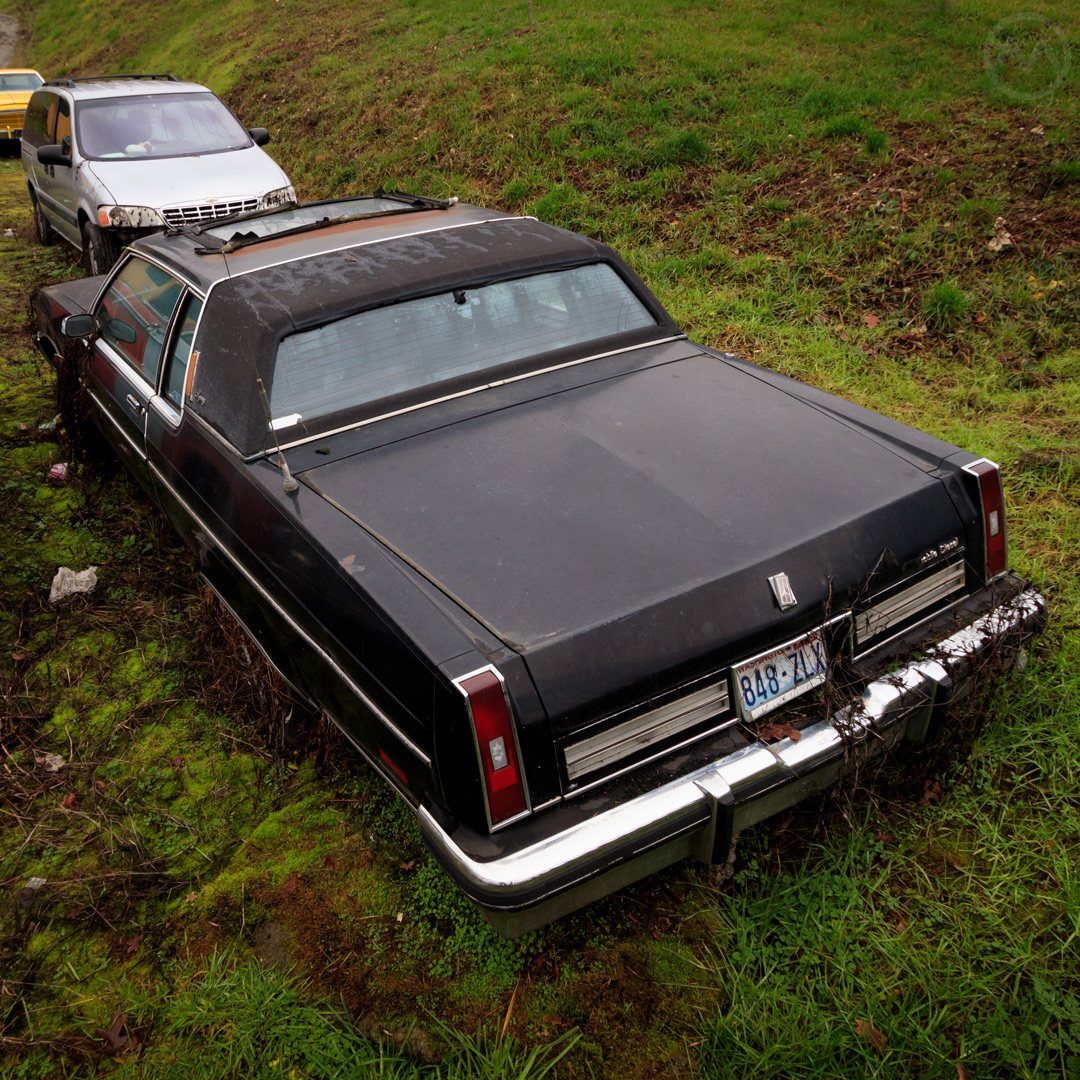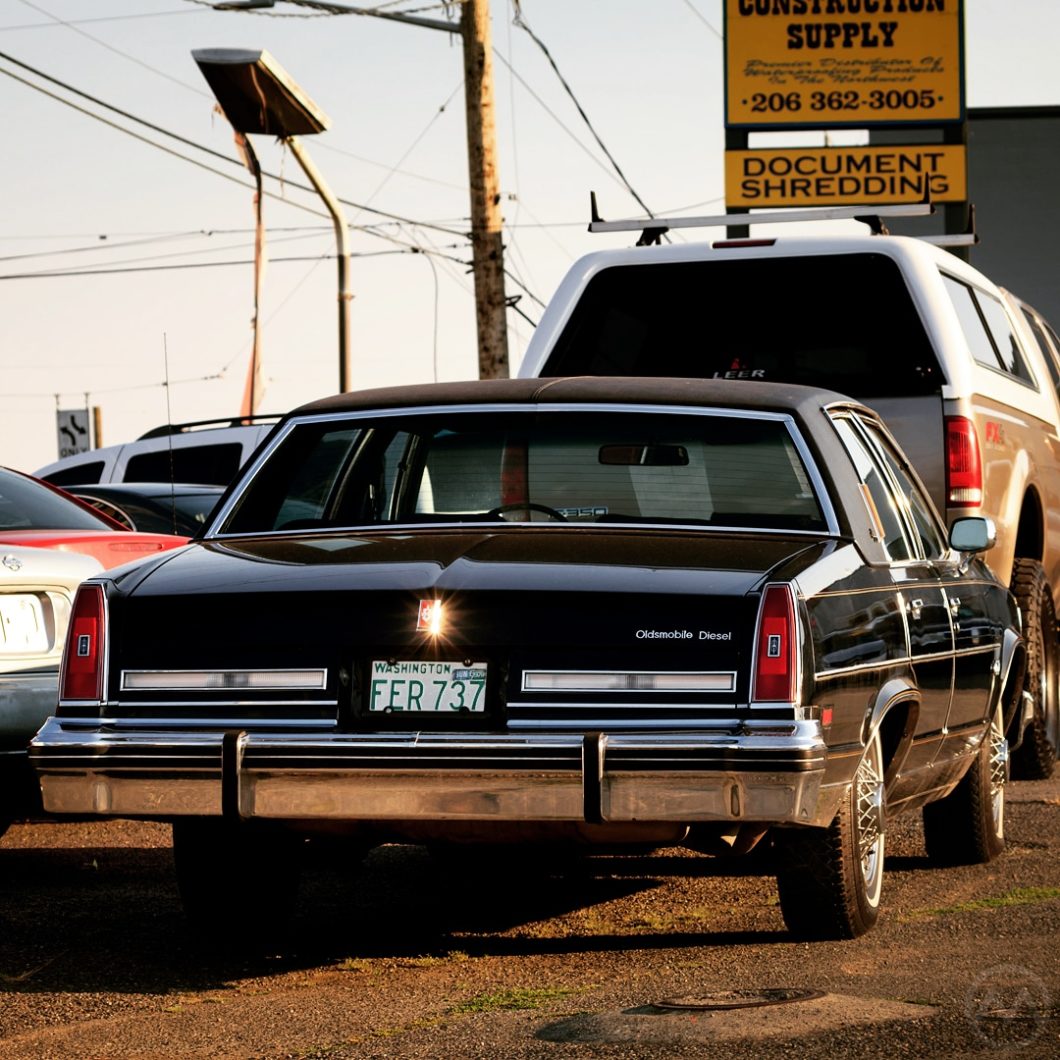By 1977 it had plenty of hsitory. Oldsmobile’s flagship Ninety Eight dated back to 1941 (spawned to replace the 1940 series 90) and had ridden GM’s big C-body with Cadillacs and primo Buicks ever since. The 98 was always “Oldsmobile’s Cadillac,” but it was more visually restrained than its cousins.
Like Lancias in Italy or Humbers in England, the Ninety Eight was for people who had means and wanted luxury but didn’t necessarily want to show off.
1977’s downsizing resulted in a more logical and better-to-drive C-body across all three luxury lines with little sacrifice in luxury or room. Olds’ version, shedding its traditional fender skirts and slab sides, seemed to be the plainest of the set. Considering the customer, it’s not so surprising that Oldsmobile buyers loved it and the Ninety Eight hit record sales – nearly 140K in 1977.
This generation of Ninety Eight (‘77-’84) was to be the model’s golden age. It’s true that in 1980-82, recession and a fuel crisis hit big cars hard – and the Ninety Eight was not spared despite a major restyle that brought back some of the pre-’77 themes; but by 1983 sales had rebounded to 120,000 cars before fading away in the long model year of 1984.
By any measure, this car was a big success for Oldsmobile, the most popular generation of 98 up to that time. But popularly, the success of this car was overshadowed by troubles with Oldsmobile’s infamous LF9 Diesel.
When the new downsized GM cars debuted in the fall of 1976, Oldsmobile was surging. In a decade when every American car was trying to be a brougham, Olds had finely honed exactly that kind of offering – it was to the 1970s as Pontiac’s performance image was to the 1960s. The new 98 was no doubt buoyed by the huge success of the Cutlass and the knock-on effect from it that swelled Oldsmobile sales overall.
Early on, the new Ninety Eight came with Olds’ 350 and 403 Gas V8s. Rock tough and plush, even in the era of emissions they were powerful and durable cars. Both of the 1977 Ninety Eight’s engines were shared with other divisions but they were fundamentally Oldsmobile products, leaving the Ninety Eight relatively immune to “engine controversy.”
This was best exemplified by an incident in 1977 that led to a class action lawsuit against GM when a Delta 88 owner noticed that a Chevy 350 had been substituted for the “Rocket” Olds 350 it was meant to have.
The big Ninety Eight came in two series – the Ninety Eight Luxury or the more gilded Ninety Eight Regency. The vast majority of buyers chose the latter – by 1979 about a 12:1 ratio in favor of the Regency. It came with Cadillac levels of equipment and a distinctively plush interior with pillowy seats and a dashboard related to the Delta 88. It was perfect for its time, but it was a time of change.
The LF9 Diesel
In 1978 (as pictured above), a new engine was added – the optional LF9 Diesel 350 V8. The LF9 was not, as some believe, a converted gas engine. It used its own nodular iron block even if it shared some things – like head bolt locations and other design features (the connecting rods are a related, but different, design) – with the Gas 350. It was an Oldsmobile design, but created on a relatively slim budget and a very abbreviated schedule.
GM had tons of institutional knowledge about diesels – it’s EMD division had led train dieselization as far back as the 1920s, and the LF9’s mechanical fuel injection system was a proven design used on millions of farm tractors. But in a big corporation, not every division shares expertise – EMD might as well have been on Mars compared to Oldsmobile division.
Later on, comments by ex-GM engineer Darrel Sand, a GM patentholder since at least 1960, may have led to the idea that it was a pure conversion. In 1983, Sand went on public record as having tried to dissuade his bosses from putting the engine into production because, in his words, it failed in test after test – broken cranks, broken blocks, leaky gaskets, and problems with the fuel pumps. Sand claimed to have been forced into retirement because of his warnings about the LF9.
Several lapses in communication and judgement also conspired against the diesel. It lacked a water separator in the fuel system, which led to corrosion in the injectors and injection pumps. When owners put “dry gas” in to counter the water-in-the-fuel issues, it ate away at the seals. The testing schedule and the rollout of the engine were also rushed. Although some GMC and Chevy Truck dealers knew something about diesels, Oldsmobile dealers had never seen one.
Nor were consumers necessarily educated on the differences of owning and operating a diesel – in 1978 most Americans heard “glow plugs” and thought of laser shows down at the planetarium.
The LF9 was noisy, rattly, sooty, and slow – a quarter-mile run might take 20+ seconds. Inside, extra sound deadening kept the car quiet but outside it sounded like a Kenworth. But it was very frugal – offering 23mpg in a genuine two-ton, six-passenger luxury car. After a slow start in 1978, about 1 in 7 Ninety-Eight buyers chose the LF9 in 1979.
1979, of course, was the year of OPEC II – though it was the 1980 models that were most affected by the second gas crisis. Suddenly MPG was all that mattered and Oldsmobile had the magic bullet. Anybody who’d plunked down for a Ninety Eight diesel in 1979 suddenly looked like a genius and many more customers followed.
Customers Revolt
Sand’s warnings about the LF9 proved correct. Customer complaints started almost immediately and many early LF9s were regularly in for service. GM downplayed the issues as best it could until things reached a head in 1982-1983.
Grassroots groups of customers began contacting each other in local papers, and by 1983 there were class action lawsuits from more than 10,000 customers and sales of the Diesel cars were way down. Part of that was the reduced price of gas and the increased price of Diesel, but the word on the street did not help.
The post-1981 LF9s were generally better and a surprisingly high number of them survive today – but they were still slow and noisy, and the customers no longer trusted them. Nor did Americans seem to trust any diesel, really, that wasn’t from Mercedes, Peugeot, or Volkswagen. Diesel sales in the U.S. and Canada began sinking in exactly inverse proportion to how they burgeoned in Europe in the 1980s.
The Ninety-Eight not only survived the diesel experience, but came back with a roar in 1982-83, selling nearly as many units as it had in 1978 and 1979. By then Diesels were a relatively small percentage of production but the big 350 and 403 engines had given way to Oldsmobile’s trusty 307 and a rarely-seen Buick-sourced 4.1L V6.

The vast majority of the first wave of this generation, the 1977-79 cars, were gas powered and had long, usually trouble-free lives. It’s rare to see an early Diesel in such condition today though.
In 1980, as we’ve mentioned previously, GM gave all of the circa-1977 B/C cars a major refresh aimed at making them more aerodynamic (to the tune of .5 to 1 mpg improvements). The Ninety Eight got the most comprehensive of these updates and looked almost like an entirely new car. One of those, with an LF9 as well, is pictured above.


Oldsmobile was a great car. It was a ” poor man’s Cadillac “, and was in fact Cadillacs’ experimental car division. New technology GM wanted was developed and tested on Oldsmobile before going on the Cadillac. Oldsmobile was a quality built, durable, and prestigious car division for many years. A friend of mine owned a 1983 Olds Delta 88 Royale with the diesel v8. It was good engine and gave no problems. It had power, torque, and better fuel economy. I was sorry to see Olds go. GM and Olds were responsible for its demise though. Olds traditional market was alienated by the ” This isn’t your fathers Oldsmobile ” marketing slogan as GM wanted Olds to go after younger buyers, with radically redesigned cars. Olds’ traditional buyer market went to Buick and Mercury, while the younger buyers stayed elsewhere. That was the end of Olds.